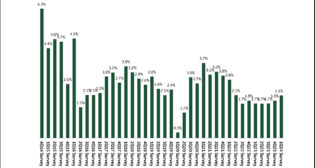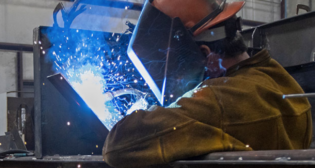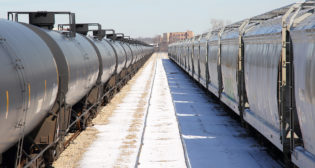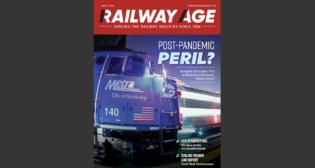
Greenbrier FY2Q2020: “Strong Liquidity, $3.2B Backlog”
Written by William C. Vantuono, Editor-in-Chief
Greenbrier Chairman and CEO Bill Furman.
Greenbrier’s fiscal second-quarter 2020 financial results (the company begins its fiscal year on Oct. 1 of the prior year) are based on orders of 8,500 railcars valued at more than $815 million, a “Strong liquidity position targeting $1 billion of available liquidity,” and a $3.2 billion backlog that “provides forward visibility.”
Second-quarter highlights:
- Base liquidity of $620 million consisting of cash of $170 million and $450 million available under “committed credit facilities with high-quality lenders. Greenbrier is targeting total liquidity of $1 billion.”
- Greenbrier’s manufacturing and service sites continue operations as “Essential Business” under directives issued by the U.S. Department of Homeland Security (DHS) and other government authorities.
- Orders for 8,500 diversified railcars were received during the quarter, with more than 50% originating from international sources. The new railcar backlog increased to 30,800 units with an estimated value of $3.2 billion as of Feb. 29, 2020.
- Net earnings attributable to Greenbrier for the quarter were $13.6 million, or $0.41 per diluted share, on revenue of $623.8 million. Net earnings include a “mutually beneficial contract modification removing railcars from backlog that would have been produced in the second half of fiscal 2020 in exchange for $9.2 million, after tax. This modification strengthens the quality and amount of Greenbrier’s backlog and improves cash on hand.”
- Adjusted net earnings attributable to Greenbrier for the quarter were $15.3 million, or $0.46 per diluted share, excluding $1.7 million, after tax, ($0.05 per share) of integration related expenses from the American Railcar Industries (ARI) acquisition.
- Adjusted EBITDA for the quarter was $71.6 million, or 11.5% of revenue.
- Board declares a quarterly dividend of $0.27 per share, payable on May 13, 2020 to shareholders as of April 22, 2020.

“Greenbrier is focused on two primary goals: protecting the safety and health of employees and preserving the economic well-being of our enterprise in this challenging environment,” said Chairman and CEO Bill Furman. “We are executing on the latter by increasing liquidity and sizing the organization properly in the current business environment.”
“Market conditions drove actions in the first half to size Greenbrier’s manufacturing footprint for lower levels of railcar demand, with reductions of 3,500 global employees to scale production capacity,” Furman noted. “Manufacturing workforce reductions were primarily in Mexico.
“Amid the uncertain and rapidly changing impacts on the global economy from the COVID-19 pandemic, Greenbrier is suspending its previously issued guidance for fiscal 2020. Greenbrier has initiated a range of proactive responses to address conditions in the rail equipment industry and the impact of the pandemic. The company is eliminating all non-essential capital expenditures and is aggressively reducing overhead and SG&A expense. Greenbrier has eliminated all non-essential travel and implemented a hiring freeze while evaluating its total operating unit footprints. Collectively, these measures will generate substantial cash savings. Finally, the members of Greenbrier’s Board of Directors, including me, have voluntarily reduced annual compensation.
“All of Greenbrier’s manufacturing and service facilities continue regular operations. Greenbrier functions as an essential infrastructure business under guidance issued by DHS and supports operations vital to the national transportation system and operations of the Department of Defense and other federal agencies, under the statutory and regulatory authority of the Department of Transportation, the Surface Transportation Board, the Federal Railroad Administration and the Jones Act. Similar guidelines and authorities exist in other nations where we operate.

“Greenbrier’s manufacturing backlog and factories will provide cash flow resiliency. With the strength of our current backlog and balance sheet, we expect to continue to operate while observing stringent health and safety protocols. Continuity of the business alongside employee health and welfare are Greenbrier’s highest priorities. Maintaining cash flow and liquidity are essential components of Greenbrier’s current operating strategy.
“Greenbrier continued to rationalize its global manufacturing footprint in the second quarter by idling excess production capacity at its North American manufacturing facilities as well as its aftermarket wheels, repair and parts locations that operate within Greenbrier Rail Services (GRS). Significant manufacturing efficiency programs also were implemented at Greenbrier facilities in Brazil and Europe in fiscal 2019.
“As mentioned above, Greenbrier’s operations constitute ‘Essential Infrastructure’ and ‘Essential Businesses’ as defined by relevant U.S. agency guidance and advisories and in all ‘stay at home’ orders issued in all U.S. jurisdictions where we operate. The only exception in our entire operating network is a planned two-week shutdown of our facilities in Europe over Easter to allow for the supply chain to normalize.
“Greenbrier is dedicated to fulfilling its role to facilitate the continued stability of transportation supply infrastructure. Greenbrier will help maintain the delivery of vital goods, including food, medical supplies and fuel to communities and to support the United States’ national security infrastructure.
“At all facilities worldwide, Greenbrier policies meet or exceed CDC recommendations. Expanded health screenings, including temperature readings, operating through split shifts, and enhanced social distancing practices have reduced the number of employees in a location at the same time. At present, Greenbrier facilities have been minimally impacted by COVID-19. Precautions and processes are in place for exposures to be reported and addressed.
“Like other companies, Greenbrier cannot predict with certainty the impact that the COVID-19 pandemic may have on our business due to numerous uncertainties, including the duration of the pandemic, the impact to customers and suppliers, actions that may be taken by governmental authorities and other consequences. As a result, Greenbrier is focused on continuous contingency planning and risk analysis. Greenbrier’s strong backlog, coupled with aggressive actions to slow down or shutter production lines and reduce overhead, leaves little open production space for the remainder of the fiscal and calendar year. Additionally, the company plans to access current and proposed government programs for strategic businesses to protect our workforce and ensure economic viability of the enterprise.”
The Cowen Insight

“International diversification, aggressive cost cutting and cancellation fees are among GBX’s defenses in this unprecedented environment,” commented Cowen and Company analyst Matt Elkott. “Similar to many others, the company suspended its guidance. EPS was a beat, driven by cancellation fees; deliveries missed our estimate; while orders significantly exceeded our forecast, driven by international orders.
“We believe that, due to the rolling nature of the coronavirus infection apexes, GBX’s international diversification could help mitigate the blow of the pandemic somewhat. The company received orders for 8,500 railcars in the quarter, with more than 50% originating from international markets. New railcar backlog increased to 30,800 units (above our estimate of 28,700 units) with an estimated value of $3.2 billion, above our $2.9 billion estimate.
“The company has implemented aggressive cost cutting measures. We believe some portion of such measures may have been in place prior to the escalation of the COVID-19 pandemic. We also believe that some portion will continue past it. Management noted that market conditions drove actions to size Greenbrier’s manufacturing footprint for lower levels of railcar demand, with reductions of 3,500 global employees to scale production capacity. Manufacturing workforce reductions were primarily in Mexico.
“Fiscal 2Q20 EPS was $0.46, above our and Street estimates of $0.30 and $0.29, respectively. Fiscal 2Q20 adjusted EBITDA was $71.6 million, compared to our and consensus estimates of $73.5 million and $68.5 million, respectively. Revenue was $623.8 million, compared to our and Street expectations of $819.3 million and $800.0 million, respectively. The gross margin was 13.8% (12.0% in fiscal 1Q20), compared to our estimate of 12.4% and consensus of 12.5%. The sequential increase was due to improved product mix and customer payment related to contract modification.
“Fiscal 2Q20 orders and deliveries of 8,500 units and 4,500 units compared to our estimates of 4,400 units and 6,000 units, respectively.”



